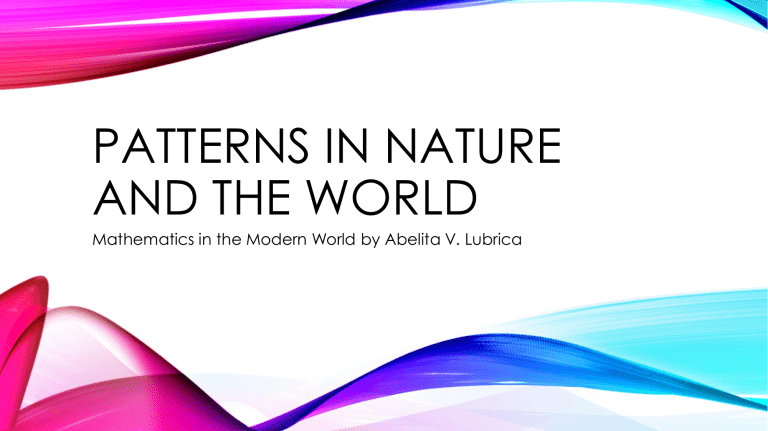
PATTERNS IN NATURE AND THE WORLD Mathematics in the Modern World by Abelita V. Lubrica OBJECTIVES OF THE LESSON: At the end of the lesson, you should be able to: 1. be aware of the different patterns that can be found in nature, 2. realize the different uses of each pattern, 3. make an interconnection between the patterns and mathematics, and 4. appreciate math and its relationship to the environment. WHAT IS A PATTERN? • a repeated decorative design (Oxford Dictionary) • a natural or chance configuration (Merriam-Webster) • a reliable sample of traits, acts, tendencies, or other observable characteristics of a person, group, or institution (MerriamWebster) • synonyms: design, decoration, motif, marking, ornament, ornamentation, device, figure WHAT ARE THE KINDS OF PATTERNS FOUND IN NATURE? 1. SYMMETRY – the quality of being made up of exactly similar parts facing each other or around an axis (Oxford Dictionaries) • Kinds of symmetry : 1. reflectional symmetry (mirror or line symmetry) - occurs when an image can be flipped around an axis and still appear the same 2. rotational symmetry - object remains the same after being rotated around a central point 3. point symmetry - occurs when every point of an image has a matching point that is the same distance from the central point but in the opposite direction REFLECTIONAL OR LINE SYMMETRY ROTATIONAL SYMMETRY ROTATIONAL SYMMETRY POINT SYMMETRY RELATIONSHIP OF ROTATIONAL AND POINT SYMMETRY USE OF SYMMETRY *efficient locomotion *gives balance and beauty (https://www.cbc.ca/radio/quirks/july-21-2018-bread-came-before-agriculturedriving-drowsiness-and-more-1.4753031/the-reason-why-most-animals-aresymmetrical-has-to-do-with-their-locomotion-1.4753044) PATTERNS IN NATURE 2. SPIRAL – winding in a continuous and gradually widening (or tightening) curve, either around a central point on a flat plane or about an axis so as to form a cone SPIRALS SPIRALS Here is a link showing the presence of spirals in nature: Part 2: Spirals in Nature https://www.youtube.com/watch?v=ewLFSIyBJkU Spirals in Nature are the Signature of the Divine Architect, aka Universal Mind! https://www.bitchute.com/video/PXUel0sLwo8d/ USE OF SPIRALS *when the plant is in spiral shape, it condenses itself causing it to be more compact, stronger, and more protected from the elements like wind, water, or sunshine *defenses of animals or plants are more robust or stronger *more efficient use of resources like water or sunlight *maximization of space *gives beauty https://www.fi.edu/math-patterns-nature PATTERNS IN NATURE 3. FRACTALS and TREES • Fractal - any of various extremely irregular curves or shapes for which any suitably chosen part is similar in shape to a given larger or smaller part when magnified or reduced to the same size - a fractal is a detailed pattern that looks similar at any scale. The small part is similar in shape and pattern to the big part and the big part is similar to the small part. ROMANESCO BROCOLLI FRACTALS – MANDELBROT SET FRACTALS- THE SIERPINSKI TRIANGLE FRACTALS • Here is a link showing fractals in nature: Fractals in Nature https://www.youtube.com/watch?v=GKYG__-HATI USE OF FRACTALS Fractals are hyper-efficient in their construction and this hyper-efficiency: *makes plants maximize their exposure to sunlight * paves efficient transport of nutrition throughout the cellular structure of living things • (https://www.diygenius.com › fractals-in-nature) USE OF FRACTALS: • fractal patterns of growth have a mathematical, as well as physical, beauty. • fractals are also used in computer graphics, data compression, and modeling complex systems. PATTERNS IN NATURE 4. Flow and meanders • Flow – move along or out steadily and continuously in a current or stream • Meander – follow a winding course MEANDER MEANDERS USE OF MEANDERS As the river bends and turns *the river path (channel) gradient is reduced *makes the water less erosive thus, also, equilibrium is maintained • (https://www.ausableriver.org/blog/why-do-streamsmeander) USE OF FLOW AND MEANDER PATTERNS • Understanding flow and meander patterns is crucial for predicting and managing floods or flood control and it is also useful for water supply management. PATTERNS IN NATURE 5. Waves and Dunes • Wave – a long body of water curling into an arched form and breaking on the shore • Dune – a mound or ridge of sand or other loose sediment formed by the wind, especially on the sea coast or in a dessert USE OF WAVES • Waves are a very important and necessary part of the functioning of the Earth. • The motions they create perform a vital role in (1)transporting energy around the globe and (2) shaping the coastlines. • Ocean waves, particularly long-travelled swells, are a very important element in the complex web of mechanisms that control the heat balance of the planet. (http://www.surf-science.org/articles/the-importance-of-waves) USE OF WAVES • Waves possess kinetic energy that can be harnessed and converted into electricity through wave energy converters. It is an example of a source of renewable energy. USE OF DUNES • Natural sand dunes play a vital role in • (1)protecting our beaches, coastline and coastal developments from coastal hazards such as erosion, coastal flooding and storm damage. • They provide (2) shelter from the wind and sea spray to man, animals and plants. • (3) provide a future supply of sand to maintain the beach. PATTERNS IN NATURE 6. Bubbles and Foam • Bubble – a thin sphere of liquid enclosing air or another gas • Foam – a mass of small bubbles formed on or in liquid typically by agitation or fermentation Bubbles, foam USE OF BUBBLES AND FOAM • In the oceans, bubbles have a useful role by helping to convert salt into an aerosol, a crucial step in creating clouds. • The purpose of foam is to provide contact time on a soiled surface to allow the wetting agents, detergents and degreasers enough time to clean or remove dirt and grease. (How the bubble bursts | Naturehttps://www.nature.com) (https://www.google.com/url?sa=t&rct=j&q=&esrc=s&source=web&cd=&ved=2ahUKEwjz5p739tP1AhWLMpQKHfcdCnkQFnoECAkQAw&url=https%3A%2F%2F cleanersolutions.net%2Fwhat-you-need-to-know-about-foam%2F&usg=AOvVaw3oK3d9yxZVZI8GgZjZqZCa USE OF BUBBLES • bubbles are also a useful survival tool, they improve hunting success or breathing underwater. • Fishes create bubble nests to house their eggs until they hatch • shrimps use bubbles to catch their prey. • Crabs blow bubbles to keep their gills moist. • Beluga whales blow bubbles underwater and express their moods with the different shapes of their bubbles. • For snails, blowing bubbles is a way to protect themselves. OTHER USE OF BUBBLES AND FOAM • Bubbles have very important applications in many fields such as shipbuilding engineering, ocean engineering, mechanical engineering, environmental engineering, chemical engineering, medical science and other fields. • Foam is widely employed for insulation, packaging, cushioning, safety. • Give beauty PATTERNS IN NATURE 7. Tessellations tessellate – decorate or cover a surface with a pattern of repeated shapes, especially polygons, that fit together closely without gaps or overlapping AN EXAMPLE OF TESSELLATION (ALSO VORONOI BY BEES) Why do honeybees love hexagons? - Zack Patterson and Andy Peterson • https://www.youtube.com/watch?v=QEzlsjAqADA USE OF TESSELLATIONS •gives beauty •efficiency in the use of space and materials like the beeswax 8. Cracks crack - break or cause to break without a complete separation of the parts USE OF CRACKS • Cracks are linear openings that form in materials to relieve stress. When a material fails in all directions it results in cracks. • (https://heathercline.zenfolio.com) USES OF CRACKS • Cracks patterns can give a valuable insights into the structural integrity of a building and other infrastructures. Understanding crack patterns can help in improving design, ensuring safety and maintaining long-term functionality of infrastructures. • indicate material failure PATTERNS IN NATURE 9. Spots and Stripes • Spot - a small round or roundish mark, differing in color or texture from the surface around it • Stripe– a long band or strip differing in color or texture from the surface on either side of it USE OF SPOTS AND STRIPES • attracting mates • camouflage • mechanism as the heat-absorbing black stripes become hotter than the reflective white one's, creating temperaturelowering strips FOOTNOTE ON THE USE OF SPOTS AND STRIPES • Another function of a zebra's stripes is too ward off biting flies that can carry deadly diseases. The wavy lines of a zebra blend in with the wavy lines of the tall grass around it. • The color of the stripes does not matter because the main predator of the zebra, the lion, is color blind. The stripes enable the zebra to blend in with the grass and it surroundings. PATTERNS IN NATURE 10. VORONOI In a Voronoi pattern, every point within a given region is closer to the “seed” inside that region than it is to any other point outside that region. Each point along a region's edge is equidistant from the two nearest seeds. It's seen in places ranging from cracked mud to giraffe skin to foamy bubbles. https://www.msichicago.org › exhibits › the-patterns › PATTERNS IN NATURE A Voronoi pattern shows the proclivity of nature to favor efficiency such as a. the nearest neighbor, b. the shortest path, c. the tightest fit and d. the maximization of resources. •Examples of Voronoi patterns are the skin of a giraffe, corn on the cob, honeycombs, foam bubbles, the cells in a leaf, and the head of garlic • Voronoi patterns optimize the distribution of resources such as water, nutrients, and light, as well as maximize the efficient use of available space. • These patterns ensure that each element in a system has access to necessary resources while minimizing wastage. THE HONEYCOMB AND URBAN PLANNING AND VORONOI • The honeycomb structure, often found in beehives, exemplifies the Voronoi pattern. Bees construct hexagonal cells that fit together seamlessly, creating a tessellated arrangement. This pattern maximizes the use of space within the hive while providing efficient storage for honey and eggs. Each cell shares walls with adjacent cells, enabling efficient temperature regulation and storage capacity. The Voronoi pattern finds applications in urban planning through its ability to optimize resource distribution, analyze spatial relationships, and guide the layout of infrastructure and services within cities. USE OF VORONOI •efficiency in the distribution of water, nutrients and light •efficient use of space •optimization or maximization of the use of resources •beauty Nature by Numbers by Cristobal Vila https://www.youtube.com/watch?v=kkGeOWYOFoA “I hope that the discussion regarding the patterns that can be seen in nature added to your knowledge.” AV Lubrica





